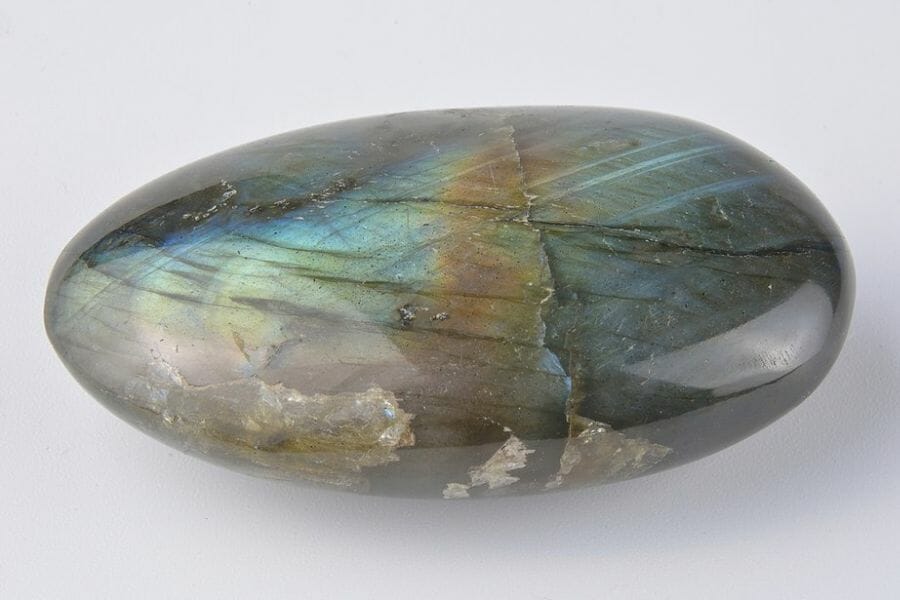When people think of their favorite color, how many of them think of gray? Maybe not too many. But did you know that there are tons of interesting, mysterious, and classic gray gems, crystals, minerals, and rocks? Plus, they have a long and fascinating history, with many of them playing important roles in human culture and society for thousands of years.
Gray gems, crystals, rocks, and minerals can be found all over the world, from the remote mountains of the Himalayas to the bustling cities of the US. Gray rocks, minerals, and gems aren’t just pretty to look at— they also have practical uses!
So, get ready to dive in and learn a little more about these fascinating natural wonders! We’ll also show you how you can identify them by color, hardness, clarity, and more.
Gray Gems and Crystals
We listed down some of the most enticing and fascinating gray gems and crystals out there. Take a close look at each of the photos we included here and see how classic-looking they are.
Cerussite – PbCO3
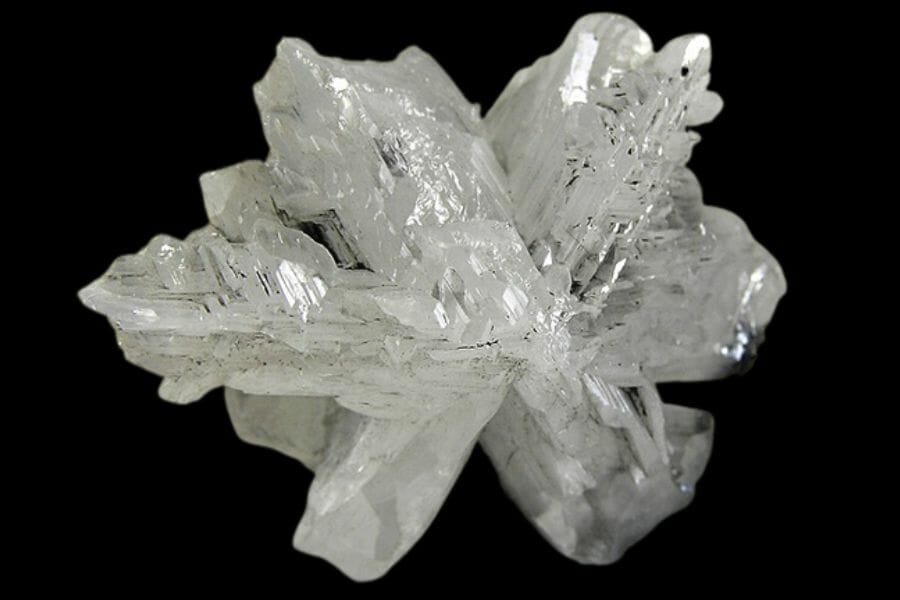
Cerussite has been known since ancient times. In fact, it was used by the Romans as a source of lead. It was also used as a white pigment in paint and as a weighting agent in the manufacture of ceramics.
This gem is valued by gem collectors for its beautiful crystal formations and its variety of colors. But what sets it apart is its bright and sparkling luster, which makes it stand out in any collection. In fact, it’s been called “lead-silver mineral” because of it.
Today, Cerussite continues to be appreciated for its beauty and versatility. If you’re a collector, or just someone who loves pretty rocks, it’s definitely worth checking out!
Fun Fact
Cerussite sometimes exhibits what's known as "Adam's needle" growths. These long, needle-like crystals can grow up to several inches in length and are highly sought after by gem collectors for their unique appearance. In fact, some of the largest Cerussite crystals in the world are now on display in museums and private collections all over the world.Where Cerussite is found
Cerussite is found in the famous Leadhills mining district in Scotland, the Broken Hill mine in Australia, the Tsumeb mine in Namibia. It’s also been found in several other countries like Morocco, Iran, and the Democratic Republic of the Congo. Cerussite is often found in association with other minerals, such as galena, anglesite, and pyromorphite, which makes it a popular target for gem collectors and geologists.
How you can identify a Cerussite
- Color: Cerussite comes in a variety of colors: from a bright, sparkling white to gray to a pale green. It can range from light to dark depending on the conditions in which it was formed. Some specimens are a single solid color, while others may have color variations and banding.
- Hardness: Cerussite has a hardness of 3.5-4 on the Mohs scale, which is considered to be soft. It can be scratched easily and may not be the best choice for jewelry or other applications that require harder materials.
- Clarity: Cerussite can be transparent to translucent, depending on the presence of impurities and inclusions. Transparent specimens are highly prized for their bright luster, while translucent ones may have a slightly milky or cloudy appearance.
- Refractive index: The refractive index of Cerussite is around 2.38, considered to be a medium-high value. It has a moderate to high ability to bend light, which gives it its bright luster and sparkle.
- Specific gravity: Cerussite’s specific gravity is 6.5. It’s relatively heavy for its size compared to other gems.
Gray Labradorite – (Ca,Na)(Al,Si)4O8
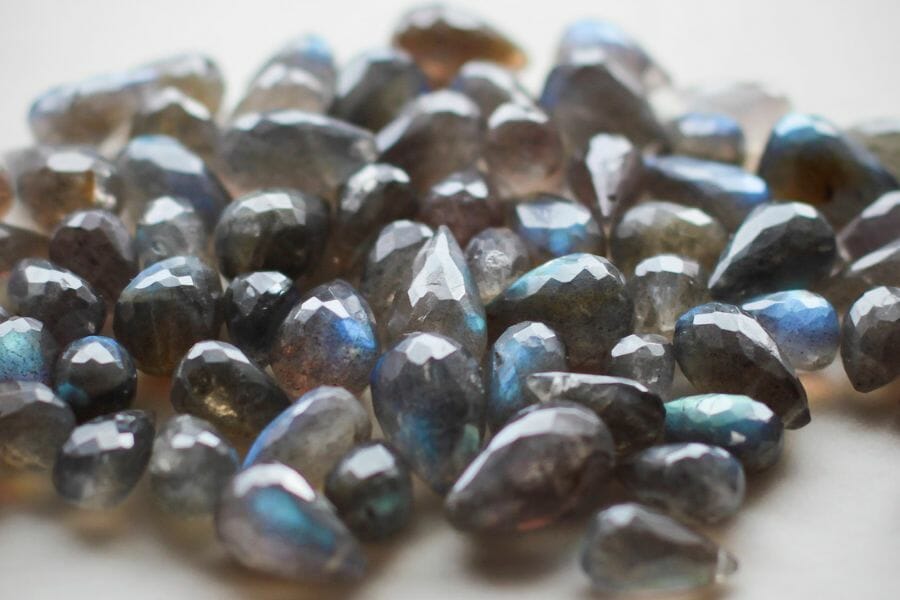
Gray Labradorite, also known as “Spectrolite,” is a variety of feldspar that was first discovered in Labrador, Canada in the late 1700s. The Inuit people have used it for centuries as a source of tools and for its spiritual properties.
Labradorite’s popularity as a gemstone has grown in recent years due to its unique and eye-catching color play. It’s often used in jewelry, such as necklaces, earrings, and rings, but it’s also used in home decor and other decorative items, like sculptures and figurines.
In addition to its beauty, Gray Labradorite is also believed to have spiritual and healing properties. It’s said to boost intuition and spiritual awareness, as well as to help bring balance and stability to one’s life.
Fun Fact Labradorite is known for its iridescent play of colors known as "Labradorescence". This iridescent color play is created by light diffraction, which occurs when light is bent as it passes through the gem's internal structure. The specific arrangement of minerals within the gem causes the light to be broken up into different colors, which results in the mesmerizing and highly sought-after color play.
Where Gray Labradorite is found
Labradorite is found in various locations around the world, including Labrador, Canada (where it got its name), Finland, and Madagascar. It’s also been found in other countries, like Australia and Norway. It’s a relatively common gem, but the gray variety with iridescent color play is less so, making it a bit more rare and sought-after. So, if you’re looking to add some Gray Labradorite to your collection, you may need to do a bit of searching to find the perfect piece!
How you can identify a Gray Labradorite
- Color: Gray Labradorite, as the name suggests, has a gray color, but it can also have a bluish or greenish tint. When viewed from different angles, it displays bright flashes of blue, green, yellow, and even red, due to light diffraction within the gem.
- Hardness: Gray Labradorite has a hardness of 6-6.5 on the Mohs scale, which makes it a relatively durable gem. It’s suitable for use in jewelry and other decorative items, but it may still scratch or chip if subjected to rough handling or extreme pressure.
- Clarity: Gray Labradorite is usually semi-transparent to opaque, with a milky to pearly luster. It’s not known for its clarity, as inclusions and other impurities are often visible within the stone. However, these impurities can enhance its iridescent color play.
- Refractive index: Gray Labradorite has a refractive index of 1.560 to 1.590, which is relatively high. This contributes to its pearly luster and iridescent color play.
- Specific gravity: Gray Labradorite’s specific gravity is 2.70 to 2.72, which means it’s relatively heavy. It means that this gem feels sturdy and substantial. This high specific gravity also means that it’s dense, making it suitable for carving and other lapidary work, as well as in jewelry.
Dolomite – CaMg(CO3)2
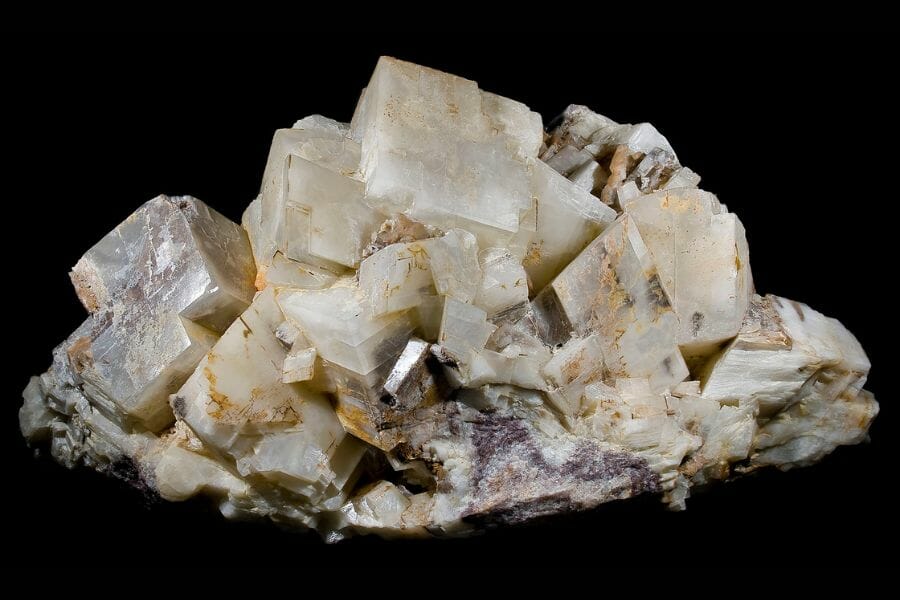
Named after the French geologist Déodat Gratet de Dolomieu, who first described it in 1791, Dolomite is commonly found in sedimentary and metamorphic rocks, making it a widely distributed gem.
Dolomite has been around for centuries and has been used in a variety of ways throughout history. It’s often used as a source of magnesium and calcium, two essential minerals for our health and in agriculture and animal feed, helping to improve the health of crops and livestock.
Dolomite is also valued for its beauty and can be found in a variety of colors. It can be used in jewelry and decorative objects, adding a touch of natural beauty to any setting.
Fun Fact A UNESCO World Heritage Site in Italy is named after Dolomite. How cool is that! The Dolomite Mountains or the "Pale Mountains" are a mountain range that straddle the borders of Italy and Austria. It's the location of some of the most ferocious battles during World War I.
Where Dolomite is found
Dolomite is a widely distributed gem that’s commonly found in sedimentary rocks, as well as in metamorphic rocks. Some of the countries where it can be found include Italy, Austria, Switzerland, Germany, and the United States (New York, Pennsylvania, Ohio, Michigan and a number of national parks like the Grand Canyon and Bryce Canyon National Parks). Dolomite is also found in smaller deposits in other countries, such as Canada, Mexico, and Brazil.
How you can identify a Dolomite
- Color: Dolomite’s color can range from white to gray, to pink, to brown, depending on where it’s from and the impurities it has. Some specimens can have a yellow or green tint to them.
- Hardness: Dolomite’s hardness is around 3.5 – 4 on the Mohs scale. It’s relatively soft, but it’s still hard enough to scratch glass. Its softness makes it a great option for jewelry that’s not for everyday wear because, with too much pressure, it can crack or break.
- Clarity: Dolomite’s clarity is low, with its milky or cloudy appearance. It can also appear translucent or opaque with a dull, matte finish, depending on the presence of impurities.
- Refractive index: Dolomite’s refractive index is usually around 1.49-1.70, which is moderate for a gem. This means that light passes through Dolomite and bends slightly, causing the it to have a slightly distorted appearance.
- Specific gravity: Dolomite’s specific gravity is an average of 2.8 – 2.9. It’s considered relatively light, but it’s still denser than other more common gems.
Gray Star Sapphire – AI2O3
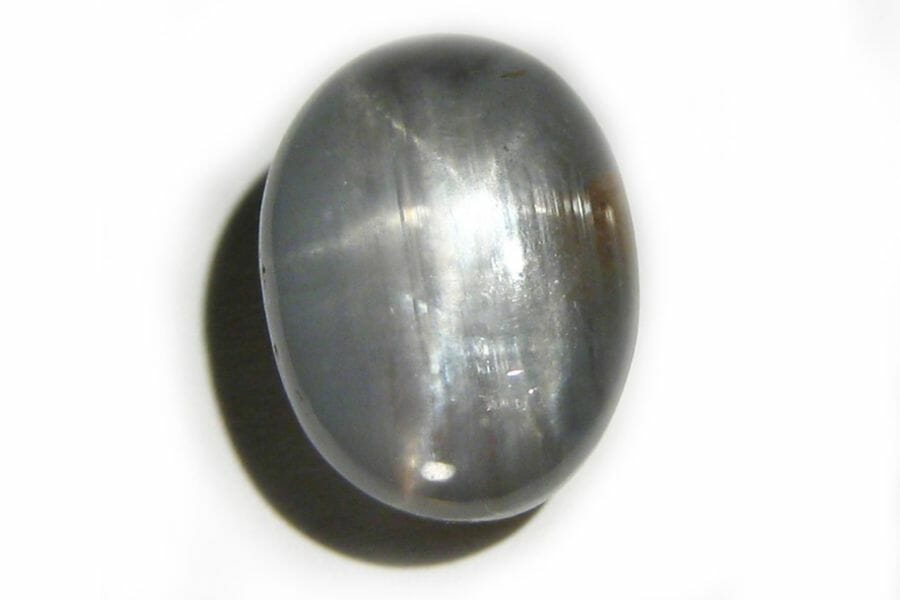
True to its name, Gray Star Sapphire is known for its beautiful star-like appearance. It’s a popular gemstone that’s been valued for its beauty and rarity for centuries.
The history of Gray Star Sapphire dates back to ancient times, when it was used by royalty and the wealthy for its ornamental value. It was also used in spiritual and religious practices, believed to bring good luck and protection to its wearer.
This gem is made up of corundum, which makes it durable and ideal for jewelry use. The unique star effect is what makes Gray Star Sapphires so valuable and sought after.
Fun Fact: Star Sapphire is so popular among gem lovers because of its star effect, also known as "Asterism". It's created by tiny needle-like inclusions that reflect light in a specific pattern, creating a star-like appearance. Truly amazing!
Where Gray Star Sapphire is found
Gray Star Sapphire is commonly found in different locations around the world, most especially in Sri Lanka, Madagascar, Thailand, Australia, Africa, and the US. The gray color of Star Sapphire is due to the presence of iron and titanium, which are abundant in these places.
How you can identify a Gray Star Sapphire
- Color: Gray Star Sapphire comes in a range of gray shades, from light to dark. It’s known for its asterism or reflection of a “star” that appears to move as the stone is rotated.
- Hardness: Gray Star Sapphire is known for its durability due to its hardness. It has a Mohs hardness of 9, making it suitable for daily wear jewelry. It’s known to be one of the hardest gemstones that’s resistant to scratches and chips.
- Clarity: Gray Star Sapphire’s clarity varies. Some are transparent and others are translucent. This depends on the presence of inclusions and the amount of air bubbles within it.
- Refractive index: Gray Star Sapphire’s refractive index is around 1.76 to 1.77, which is considered to be average for sapphires.
- Specific gravity: Gray Star Sapphire has a specific gravity of 3.95 to 4.03, which is average for sapphires and gems in the corundum group.
Platinum Rutilated Quartz – TiO2
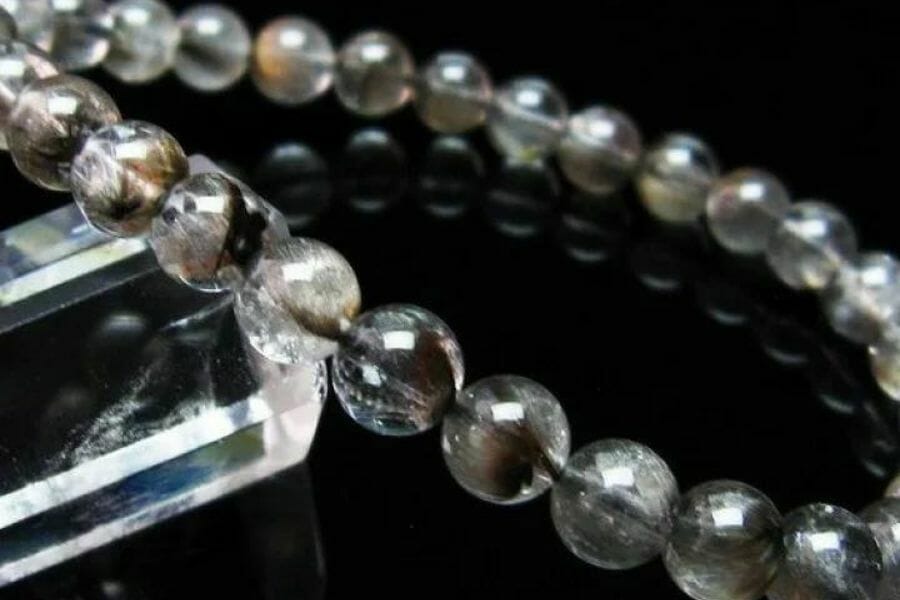
Platinum Rutilated Quartz, a type of quartz with needles of platinum, has a rich history and has been prized for its beauty and rarity for centuries.
This gemstone has been used in jewelry and other decorative objects, and is highly valued for its stunning appearance and unique characteristics. In ancient times, it was believed to have mystical powers and was used in various religious and spiritual practices.
Today, Platinum Rutilated Quartz continues to be highly sought after for its interesting looks. Its value is largely determined by the quality and quantity of the platinum inclusions found in it.
Fun Fact:
Platinum Rutilated Quartz is believed to have strong healing and spiritual properties, and is often used in meditation and energy healing practices. Some believe it can help with stress, anxiety, and other emotional issues. They say that the long, thin inclusions of platinum in the gem help to channel energy and amplify the its natural healing properties.Where Platinum Rutilated Quartz is found
Platinum Rutilated Quartz is found in various locations across the world, including Brazil, Madagascar, Switzerland, and the USA. The mines in Minas Gerais, Brazil are known to produce high-quality varieties of this gem, making it a popular source of Platinum Rutilated Quartz.
How you can identify a Platinum Rutilated Quartz
- Color: Platinum Rutilated Quartz’ color ranges from clear to smoky-gray. It’s characterized by fine rutile inclusions, which gives it a metallic sheen and sparkle. Its color also depends on the quality and concentration of these rutile inclusions.
- Hardness: Platinum Rutilated Quartz’ hardness is rated at 7 on the Mohs scale. It’s considered a durable gem that’s suitable for jewelry or other items that may be subject to wear and tear.
- Clarity: Platinum Rutilated Quartz’s clarity is usually quite good, with a transparent to semi-transparent appearance. It’s determined by the presence of fine, shining rutile needle inclusions, as well as the overall quality of the cut.
- Refractive index: Platinum Rutilated Quartz’ refractive index is 1.54-1.55, which is considered medium for gemstones. It displays moderate fire and brilliance, giving it a lustrous appearance.
- Specific gravity: Platinum Rutilated Quartz has a specific gravity of 2.65-2.66, which makes it considered to be a medium-heavy gem. The presence of platinum rutiles in the quartz gives it a higher density than pure quartz.
Gray Agate – SiO2
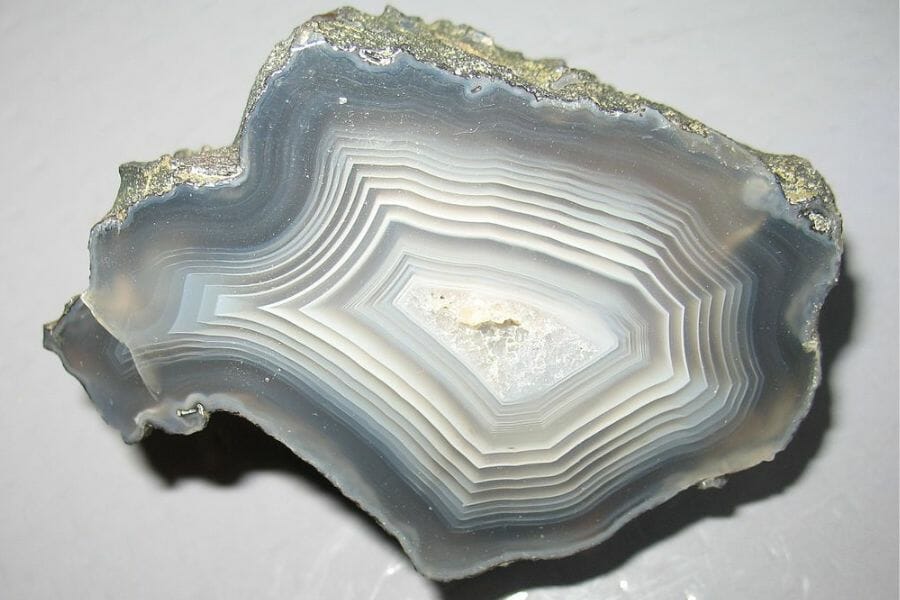
Gray Agate, known for its distinctive gray color, has been valued and used for thousands of years, dating back to ancient civilizations. It’s highly prized by the ancient Greeks, who carved intricate designs into it and used it in jewelry and as talisman.
Gray Agate has a smooth surface and a delicate, classic quality that makes it perfect for carving and polishing. It’s also often used in jewelry making, especially in pendants, necklaces, and bracelets, as well as in home decor, such as coasters, bookends, and sculptures.
Its calming energy has made it a popular choice for meditation and spiritual practices, and its grounding energy is said to help bring balance to the mind and body. It’s also believed to have protective properties, making it a popular choice for making talismans and amulets.
Fun Fact: In the Bible, a breastplate made out of 12 gemstones, was created for Aaron, the High Priest of the Hebrews. Agate was one of these gems. Talk about ancient!
Where Gray Agate is found
Gray Agate is commonly found in locations such as Brazil, Mexico, India, Madagascar, Russia, and the USA. It’s often extracted from volcanic rocks, which makes it abundant in volcanic regions. Some of the most famous Gray Agate deposits are located in Brazil, where the volcanic activity has created perfect conditions for this gemstone to form.
How you can identify a Gray Agate
- Color: Gray Agate’s usually a light to medium shade of gray, sometimes with white or black inclusions. It’s often prized for its unique and intricate patterns.
- Hardness: Gray Agate’s hardness is 6.5 to 7 on the Mohs scale. This means it’s a relatively durable gem that’s well suited for jewelry-making and other decorative purposes.
- Clarity: Gray Agate has a clarity that ranges from translucent to opaque, depending on its variety and quality. The presence of impurities or inclusions can give it a cloudy appearance.
- Refractive index: Gray Agate’s refractive index falls within the range of 1.540 to 1.550, which is similar to that of many types of quartz. The exact value will depend on the specific mineral inclusions and the conditions under which it formed.
- Specific gravity: Gray Agate’s specific gravity ranges from 2.58 – 2.64, which is considered medium value. It’s relatively heavy, giving it a substantial feel when held in hand.
Cordierite – (Mg,Fe) 2Al 4Si 5O 18
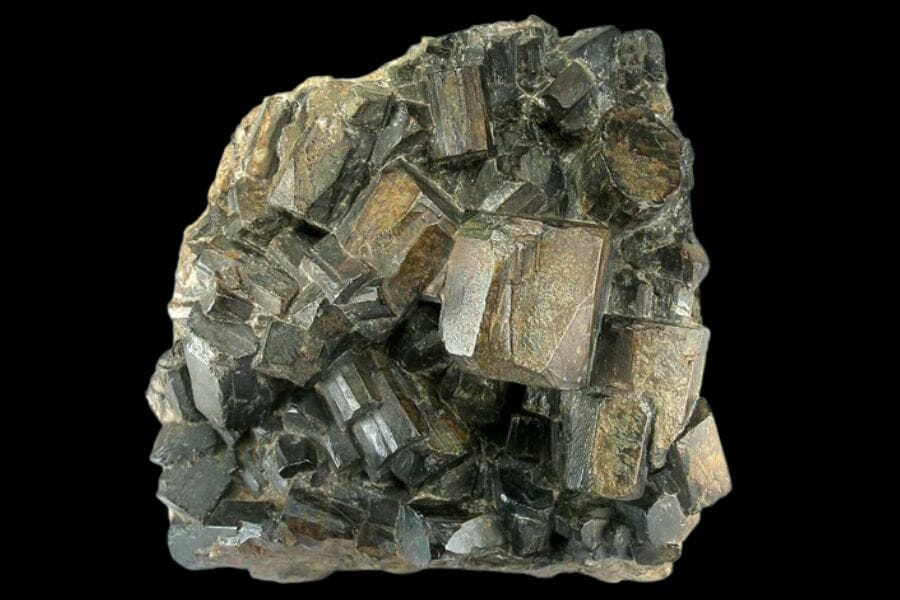
Cordierite, also known as iolite, has been used for many centuries. It was first discovered in 1813 in France, and it was named after the French geologist Pierre Cordier.
Cordierite has been valued for its beauty and its use in a variety of applications. It has been prized for its deep blue to violet color and its attractive pleochroism or the ability to show different colors when viewed from different angles.
Cordierite has also been used in ceramics and as a refractory material, as it can withstand high temperatures and has excellent thermal shock resistance. In industry, it is often used in catalytic converters and other high-temperature applications.
Fun Fact Did you know that Cordierite is also called "Vikings' Compass"? It's because of its effectiveness in determining the direction of the sun on overcast days. In fact, real Vikings have used it for this purpose!
Where Cordierite is found
Cordierite can be found in several locations across the world including Madagascar, Pakistan, Sri Lanka, Russia, Afghanistan, and Italy. It’s commonly found in high-temperature metamorphic rocks and, in some rare occurrences, can be found in volcanic rocks. Cordierite is also found in small quantities in pegmatites and alluvial deposits. It is considered a relatively uncommon gem, which makes finding it in significant quantities more challenging, but its rarity and unique characteristics make it a highly sought after gemstone.
How you can identify an Cordierite
- Color: Cordierite’s color is typically blue, bluish-gray or blue-violet. Its color is believed to be caused by iron, manganese, and magnesium impurities within its crystal structure. Some specimens may even exhibit a light banding or mottling effect.
- Hardness: Cordierite ranges from 5 to 6 on the Mohs scale of hardness. It’s resistant to breaking or chipping, but it’s not recommended for use in jewelry or other applications where it will be subjected to heavy wear, as it’s not as durable as other gems.
- Clarity: Cordierite’s clarity ranges from transparent to translucent. It has a vitreous (glass-like) luster, giving it a smooth, shiny appearance. However, some stones may have inclusions and cracks, which can affect their clarity.
- Refractive index: Cordierite’s refractive index is typically between 1.520 and 1.523. It’s relatively high, which gives this gem a moderate amount of brilliance and can result in a pale blue or pale green color when viewed in certain lights.
- Specific gravity: Cordierite’s specific gravity is around 2.7-2.8. It’s light-weight and has low density, which makes it suitable for use in ceramics and other applications where lightweight and low thermal expansion are important.
Gray Rocks
Gray gemstone’s classic look aren’t the only ones worth looking into, because in the realm of everything gray, gray rocks are sure to amaze you, too!
Dolostone
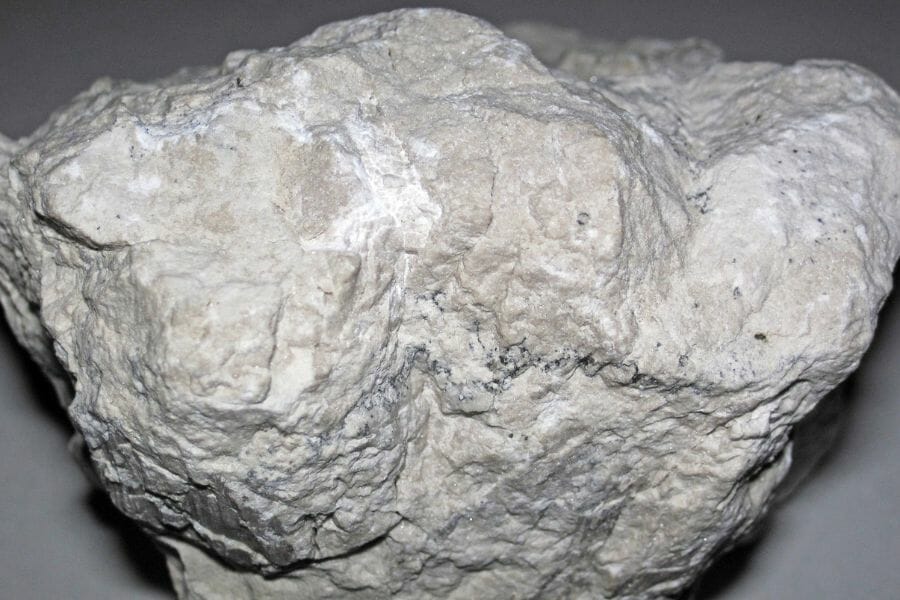
Dolostone is a type of sedimentary rock that forms from the alteration of limestone by magnesium. It’s composed primarily of dolomite.
The history of Dolostone dates back to the 1790s. Since then, it has been used in a variety of applications due to its physical properties. One of the main uses of Dolostone is as a building material. Its durability and resistance to weathering make it a popular choice for construction, especially in areas where limestone is scarce.
It is also used in agriculture as a soil amendment due to its ability to increase the soil’s magnesium content, which is important for healthy plant growth. In addition, it’s sometimes used in the production of magnesium compounds and as a filler in certain industrial applications.
Fun Fact Dolomite and limestone are like fraternal twins— there's often little distinctions between them! In fact, they're both considered to the basic building blocks of the construction industry.
Where Dolostone is found
Dolostone can be found in many parts of the world. Some of the major places it can be found include Europe (Austria, Italy), Africa (Morocco, Tunisia), Asia (China, India, Pakistan), and North America (Canada, USA). It’s also found in Australia, but in smaller deposits.
How you can identify a Dolostone
- Color: Dolostone’s color varies from white, light-gray, tan, yellow, pink or brown. It has a unique color pattern that is the result of its composition and formation process. It’s known for its distinctive banding patterns.
- Hardness: Dolostone’s hardness can range from 3 to 4 on the Mohs scale. It’s a relatively soft rock, but it’s harder than many other sedimentary rocks like limestone and chalk. This made it popular for use in sculptures and other decorative objects.
- Clarity: Dolostone can be translucent to opaque, so its clarity depends on the amount of calcite it contains. It’s impurities can affect its clarity, too.
- Refractive index: The refractive index of Dolostone typically ranges between 1.485-1.490. It’s lower compared to other rocks, which means light moves through it at a slower speed.
- Specific gravity: Dolostone’s specifc gravity is typically 2.6-2.7 g/cm3, which is considered moderate. It’s not too heavy nor too light, making it suitable for various uses in construction and industrial applications.
Chert – SiO2
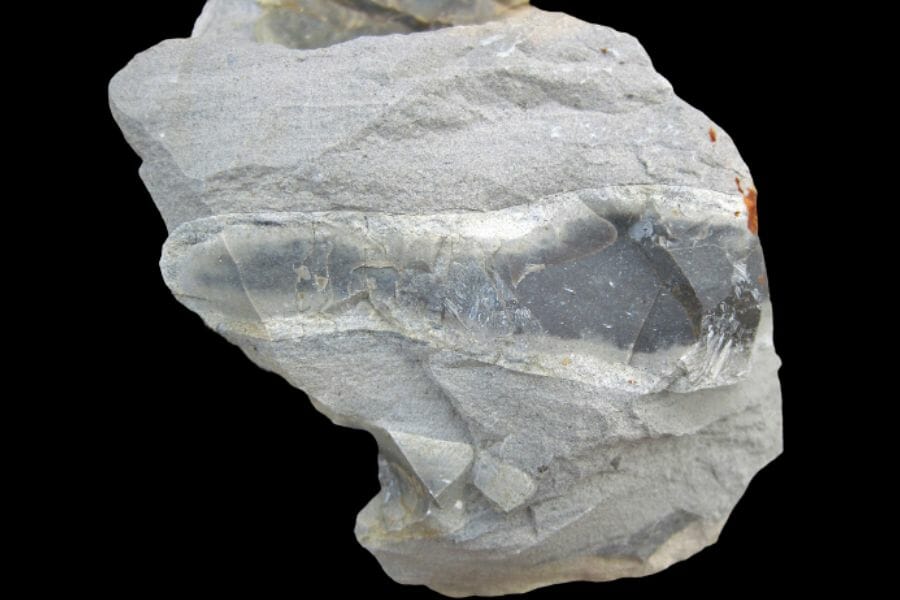
Chert is a sedimentary rock that’s type of flint. It’s widely valued because of its unique properties and characteristics, making it ideal for many applications and uses throughout history.
The ancient Egyptians were known to use chert in the construction of buildings, tools, and weapons. It was also used as a trade item, especially in the ancient Middle East, where it was traded as far as India and China. In medieval Europe, Chert was used as a building material, as well as for making tools, such as knives and other cutting implements.
Chert is still valued today for its various uses and is prized for its durability, resistance to wear and tear, and for its sharp edges. Such as versatile find!
Fun Fact: Over 2 million years — this is how long humans have been using Chert! In fact, some of the earliest stone tools ever discovered were made from it. And would you believe that it was also used as a fire starter by the Neanderthals?
Where Chert is found
Chert can be found in different places around the world, including North America, Europe, Asia and Australia. It’s commonly found in sedimentary rock formations like shale and limestone, as well as in some volcanic rocks like rhyolite. Some of the famous chert deposits include the Flint Ridge in Ohio, the Thomas Farm in Georgia, USA, and the Dales Gorge in Western Australia. Chert deposits have also been found in regions like the UK, France, Germany, Russia and China.
How you can identify a Chert
- Color: Chert is usually gray, white, or black, but can also be red, yellow, or green. Color is a result of its iron content, with reds and yellows often being iron-rich varieties. The white or gray color is due to the lack of iron.
- Hardness: Chert’s hardness can range from 6 to 7 on the Mohs scale. This is usually higher compared to other types of sedimentary rocks, which makes it a good option for several industrial uses such as millstones, oil well drilling, and as an abrasive material.
- Clarity: Chert’s clarity ranges from translucent to opaque. It can also have inclusions, such as bubbles, minerals, or other sediments that can affect its clarity. Some chert, on the other hand, may have distinctive layered or banded structures that make it clearer.
- Refractive index: The refractive index of Chert can range from 1.450 to 1.550, so when light passes through this rock, it slows down and bends, making it appear to be a different color than its original hue.
- Specific gravity: Chert’s specific gravity can range from 2.58-2.65. Some types of Chert have a relatively higher specific gravity compared to others due to their high silica content.
Diatomite
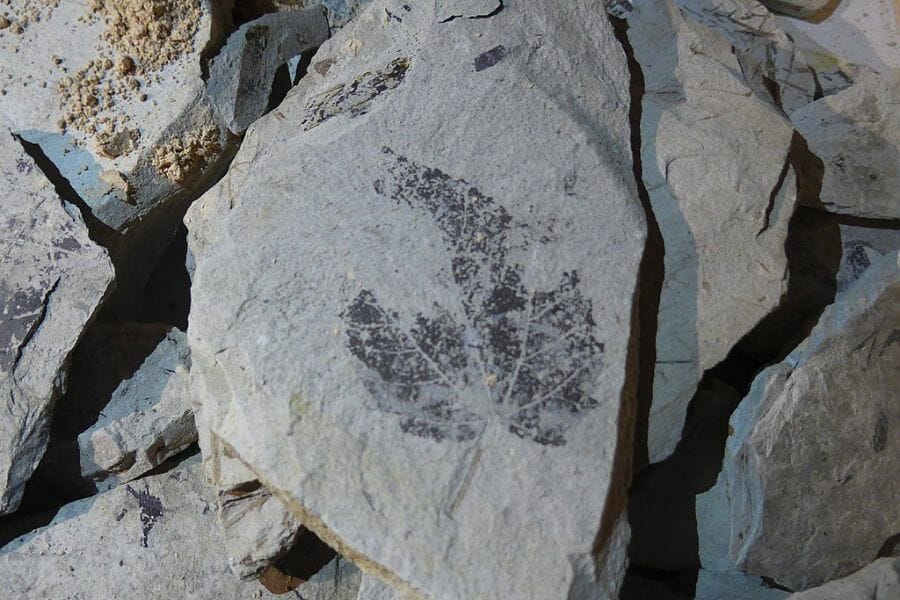
Diatomite is a sedimentary rock that’s made up of microscopic remains of diatoms, which are single-celled algae that lived in ancient oceans and lakes.
It was first used in the 1800s as a filler in paint, but it wasn’t until the 20th century that it was discovered to have a variety of industrial uses. The rock’s unique properties— it’s lightweight, porous, and has a large surface area— make it useful in a range of industries, including agriculture, filtration, and construction.
Diatomite is considered a renewable resource because it’s made from naturally occurring materials and can be mined without causing harm to the environment. This, along with its versatility, makes it a valuable commodity in a number of industries!
Fun Fact: If you have a cat, then you've been benefitting from Diatomite since you've had your lovely pet! Did you know that this rock has been a main ingredient of many absorbents, including cat litter? That's right! It's because Diatomite has excellent ability to soak up liquids.
Where Diatomite is found
Diatomite is found in various parts of the world, but it’s more common in certain regions. In the US, it’s primarily found in the western states of California and Nevada, as well as in Oregon and Idaho. It’s also found in other countries, such as Germany, Denmark, and France, and in large deposits in China, Japan, and Russia. It’s also known to be present in several other countries in Europe, Asia, and South America. Diatomite deposits are also found in lake beds and marine sediments.
How you can identify a Diatomite
- Color: Diatomite often has a light, off-white, or light gray color. Since it’s formed from the microscopic fossilized shells of diatoms, its color can vary depending on the type of diatoms and other mineral impurities present in it.
- Hardness: Diatomite’s typically rated a 2-3 on the Mohs scale, which makes it relatively soft. This softness is due to its high porosity and delicate structure, so it’s not a good choice for applications that require a lot of abrasion resistance.
- Clarity: Diatomite has a clarity that is usually translucent or opaque, depending on the thickness of the deposit and the degree of compaction.
- Refractive index: Diatomite’s refractive index is usually low, ranging from 1.4 to 1.5. Despite this, it has a relatively high level of light scattering, which makes it an ideal material for various industrial applications, such as filtration, thermal insulation, and abrasives.
- Specific gravity: Diatomite has a low specific gravity, ranging from 2.2 to 2.4 (g/cm³). It’s a very lightweight rock due to its porous structure.
Limestone – CaCO3
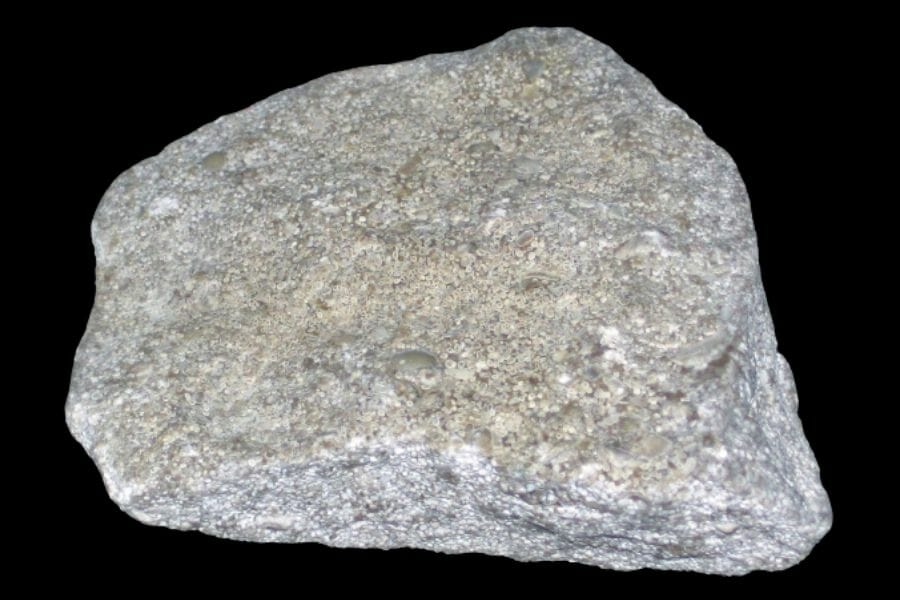
Limestone is a sedimentary rock that’s been around for millions of years, formed by the accumulation of shells, skeletons, and other materials in ancient oceans and lakes. It has been used for thousands of years in construction, agriculture, and industry.
In the early days, it was used to build the pyramids in Egypt, as well as some of the most famous buildings and monuments in Europe, such as the Colosseum in Rome and the Parthenon in Athens. In agriculture, it’s used for soil improvement to neutralize acidic soils, and to help crops grow. In industry, Limestone’s used for cement production and as a filler in products like paint and rubber.
Limestone is valued for its unique appearance, too. With its natural beauty and rich colors, it’s often used as a decorative stone in landscapes, as well as in homes and businesses.
Fun Fact Do you ever feel that sense of relief when you burp? Well, drinking carbonated beverages can bring that same relief. Many sodas and antacids used to treat heartburn contain calcium carbonate as the active ingredient, which is sourced from— guess what — Limestone! So, the next time you pop a Tums or an Alka-Seltzer, keep in mind that you're basically consuming a rock to calm your stomach.
Where Limestone is found
Limestone can be found in many places worldwide, including in Europe, Asia, Africa, North America and South America. Some of the world’s largest limestone deposits can be found in the United States, in states like Texas and Missouri. It’s also found in parts of the Caribbean and Mexico, where it’s been used for construction for centuries.
Limestone’s often found near the surface, making it easily accessible for excavation, and in large deposits in areas with shallow sea beds. It’s formed by sedimentation, mostly from the shells of marine organisms, so it’s also found in caves and underground springs. It’s a widely distributed rock, which is why it’s an important and valuable resource.
How you can identify a Limestone
- Color: Limestone’s often a light-to-medium gray, tan, or beige. Some can also have shades of yellow, pink, red, or brown, and can even appear blue or green. Some can also have unique and distinctive banding patterns (like stripes or spots) or have visible fossils or shell fragments.
- Hardness: Limestone’s hardness can vary depending on its type. Some, like chalk or coquina, are quite soft at around a 2 or 3 on the Mohs scale, while others, like travertine or marble are much harder at around a 4 or 5.
- Clarity: Limestone can be translucent to opaque, with sometimes visible impurities or inclusions that affect its clarity. Its clarity is also influenced by factors such as mineral content and the degree of compaction of the rock.
- Refractive index: Limestone’s refractive index is usually between 1.485 and 1.488, depending on its type. It’s lower than that of many common rocks, which means it doesn’t bend light as much.
- Specific gravity: The specific gravity of Limestone can range from 2.5-2.7, which means it’s relatively light compared to other rocks due to its high porosity.
Dacite
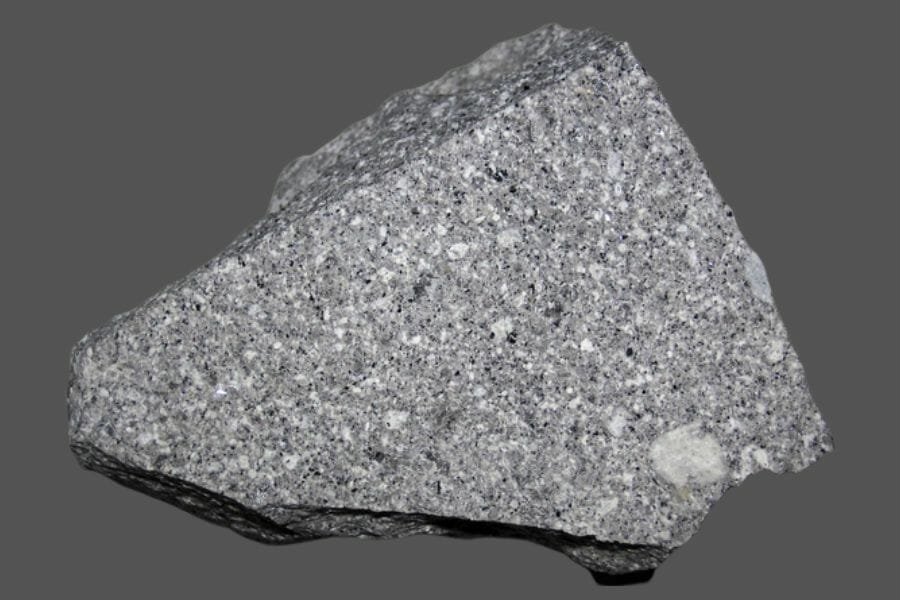
Dacite is a volcanic rock that’s formed from the solidification of magma or lava. It’s believed to be a result of partial melting of the Earth’s mantle and is often associated with explosive volcanic eruptions.
In the past, Dacite was used as a building material as it’s durable and relatively easy to shape. It’s also been used in the production of ceramics and as a source of silica for glass production. Dacite is also used in the production of abrasives and as a filler in the rubber and paint industries.
Today, Dacite’s porphyritic texture and light color make it a popular choice for use in decorative applications, such as sculptures, flooring, and countertops.
Fun Fact Did you know that Dacite's name originated from Dacia, an area in the Roman Empire that was located between the Danube River and Carpathian Mountains (which are now present-day Romania and Moldova). It was in this region where the rock was first identified and described.
Where Dacite is found
Dacite can be found all over the world, with concentrations in volcanic areas and mountain ranges. Some of the most notable deposits can be found in North America, Europe and the Andes Mountains of South America. In the U.S., Dacite can be found in western states such as California, Nevada, and Washington. In Europe, it’s found in Italy, Iceland, and France. In South America, it’s primarily found in Chile and Argentina. These are just a few of the many locations where this rock can be found, with others scattered throughout the world in areas that have experienced volcanic activity.
How you can identify a Dacite
- Color: Dacite can vary in color, but is often gray or light-colored, like tan or pinkish. Sometimes, it can have brown or black streaks. It can also have small white crystals or mineral inclusions that give it a speckled appearance.
- Hardness: Dacite’s hardness on the Mohs scale falls between 5 and 7, depending on the specific composition of the sample. It’s durable enough for use in construction and landscaping, but also allows it to be carved and shaped for ornamental purposes.
- Clarity: Dacite is usually described as translucent to opaque. Its exact clarity depends on the amount of mineral and mineral grain size present within it.
- Specific gravity: The specific gravity of Dacite varies depending on its mineral composition and texture. Typically, it ranges from 2.6 to 2.7, which is considered to be a bit lighter than average for igneous rocks.
Phyllite
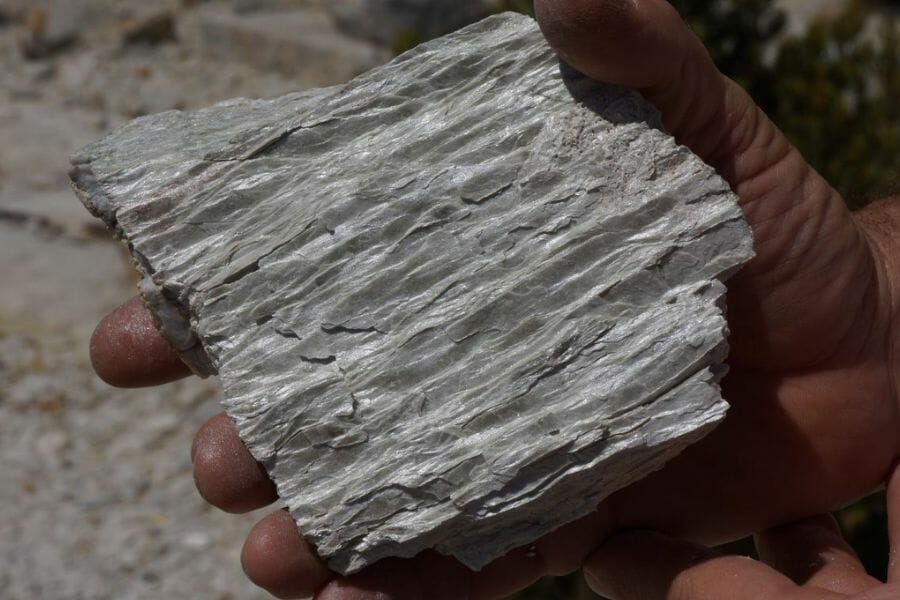
Phyllite is a type of metamorphic rock that forms from the alteration of shale. It has been used for various purposes throughout history, such as construction material, roofing, flooring, and more.
In ancient times, Phyllite was a popular choice for building temples, houses and other structures due to its durability and weather resistance. It was also used to make weapons, tools and decorative objects. The rock was highly valued by ancient civilizations for its beauty and versatility.
Phyllite’s high silica content makes it ideal for use in a variety of industrial applications, such as abrasives, insulation, and filtration. It’s also used in cosmetic products due to its natural exfoliating properties. Such versatility in one rock!
Fun Fact Phyllite is known for its fine grain and layered appearance. The name "Phyllite" is Latin, which literally means "leaf-stone" because of its ability to be split into thin sheets. It's a fissile rock, meaning it can be easily divided into flat pieces due to the parallel arrangements of platy minerals formed during its formation through metamorphism.
Where Phyllite is found
Phyllite is found in various parts of the world, including in mountain belts and terrains that have undergone metamorphism. These areas include the Appalachian Mountains in the Eastern US, the Scottish Highlands, parts of Europe and Asia, and several other regions. It’s also commonly found along fault zones and in areas with a high concentration of tectonic activity.
How you can identify a Phyllite
- Color: Phyllite is known for its typical green color, but it can range from gray to greenish-gray, to black and sometimes has light, white-grey streaks due to the presence of mica minerals.
- Hardness: Phyllite’s hardness is usually in the range of 2.5-4 on the Mohs scale, but its toughness and ability to split into thin sheets can make it somewhat brittle.
- Clarity: Phyllite is usually cloudy, opaque or translucent due to its fine-grained nature and metamorphic origin. Its natural layering and parallel alignment of platy minerals contribute to its opaque appearance.
- Specific gravity: The specific gravity of Phyllite is typically 2.5-2.8, which is considered to be medium to high for metamorphic rocks. This means that it’s relatively dense and heavier that other rocks due to the presence of dense minerals.
Gray Minerals
Now that you know about gray gems, crystals, and rocks, let us take you to the wonderful and enticing world of gray minerals that will show you how beautiful classic looks like.
Crocidolite – Na2[Z2+3Fe3+2]Si8O22(OH,F,Cl)2
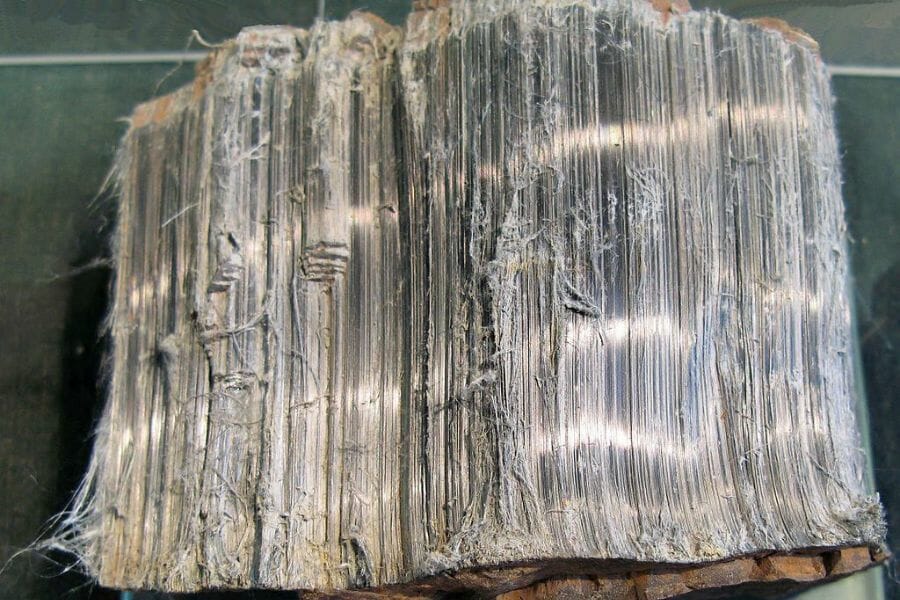
Crocidolite, also known as blue asbestos, is a fibrous amphibole mineral that was widely used in the 20th century. It was valued for its durability, heat resistance, and ability to be woven into flexible materials, making it ideal for use in insulation, fireproofing, and construction materials.
However, the health hazards associated with Crocidolite became increasingly apparent during the mid-20th century. Long-term exposure to its fibers has been linked to a range of serious respiratory diseases, including lung cancer, mesothelioma, and asbestosis.
As a result, the use of Crocidolite has been largely banned or regulated in many countries, and it is now considered a hazardous material that must be handled with extreme caution.
Fun Fact:
Crocidolite was named after its fibrous structure which resembles that of a caterpillar, or "crocidos" in Greek. Where Crocidolite is found
Crocidolite is found in various places across the world, including South Africa, Namibia, Russia, and Australia. It’s also found in smaller amounts in regions of Brazil, Zimbabwe, and Madagascar. It’s often mined as a valuable type of asbestos, which was once widely used in construction and insulation, but has since been banned due to health risks. Despite this, Crocidolite is still sought after for its strength and heat-resistant properties, making it valuable for industrial purposes.
How you can identify a Crocidolite
- Color: Crocidolite is often described as having a blue-gray or gray-blue hue with a slight greenish tint. Its color can vary based on the presence of other elements, as well as its overall purity and formation conditions.
- Hardness: Crocidolite has a hardness of 5.5 to 6 on the Mohs scale, which makes it a relatively soft mineral. Due to its softness, Crocidolite can easily be scratched with a knife or other hard object.
- Clarity: The clarity of Crocidolite varies, but it’s generally a translucent to opaque mineral. It’s often described as having a glassy appearance, but this can vary depending on the quality of the specimen and the size of the fibers.
- Refractive index: Crocidolite’s refractive index varies between 1.57-1.64, which is lower compared to other forms of asbestos. This property allows it to scatter light effectively but also makes it more difficult to see individual fibers of the mineral.
- Specific gravity: Crocidolite’s specific gravity ranges from 2.9 to 3.3, which is considered heavier than average for most minerals.
Thenardite – Na2SO4
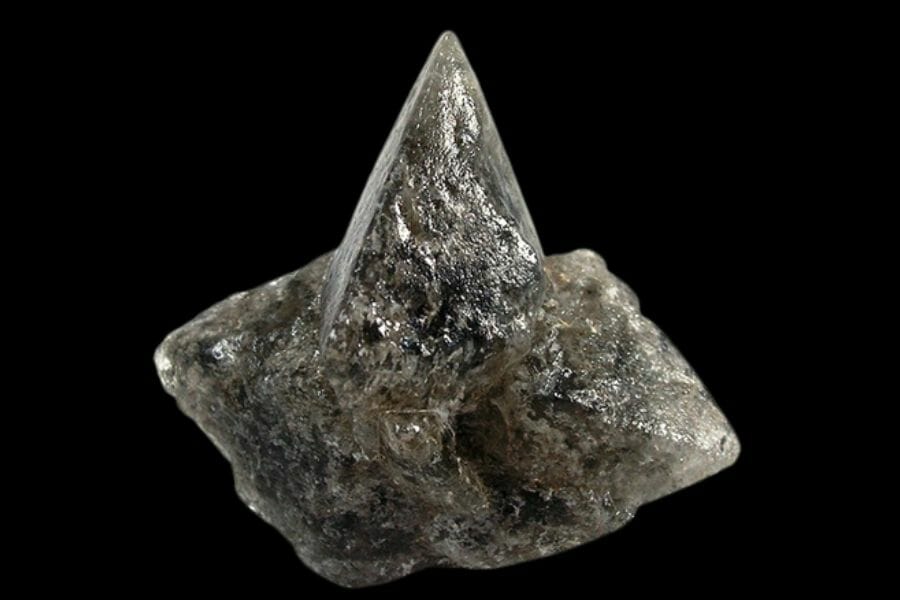
Thenardite was first discovered in the 18th century and was initially recognized as a compound of sodium and sulfate. This mineral is often associated with other evaporite minerals like halite, sylvite, and carnallite.
One of Thenardite’s earliest applications was as a source of sodium for the production of soda ash, which is an important component in the production of glass, soap, and paper. In recent times, it has become a valuable resource for the mining of potash and other minerals that are used in fertilizer production.
Thenardite is also of scientific interest, because it’s known to form in high temperature and high salt concentration environments. This makes it a useful tool for understanding the geology of arid regions and the processes that occur in evaporite basins.
Fun Fact:
For many who are familiar with it, Thenardite is interesting for its high salt content. This makes it useful as a natural desiccant and has been used in the preservation of food, hides, and other materials. A true ally of food lovers out there!Where Thenardite are found
Thenardite is found in arid regions, such as deserts and salt lakes, where evaporation has caused a buildup of sodium salts. It’s commonly found in playa salt pans and salt flats, which are flat, low-lying areas that are seasonally covered in water and salt. These types of environments are found in many parts of the world, including the Mojave and Great Basin deserts in the western U.S., the Atacama Desert in South America, and the Danakil Depression in Ethiopia.
How you can identify a Thenardite
- Color: Most of the time, Thenardite is colorless, but it appears white or grayish to the naked eye. Its exact color depends on the presence of impurities.
- Hardness: The hardness of Thenardite is 2-2.5 on the Mohs scale, which is considered quite soft and is easily scratched by a fingernail or knife. Despite its softness, this rock is known for its high solubility in water.
- Clarity: Thenardite doesn’t have a high level of clarity due to the presence of inclusions and fractures, which can affect its translucency.
- Specific gravity: Thenardite’s specific gravity is considered high, usually at 2.2-2.4. Due to its high salt content, it is heavy for its size. It’s also soluble in water, so it will weigh less in water than in air.
Arfvedsonite – [Na][Na2][(Fe2+)4Fe3+]
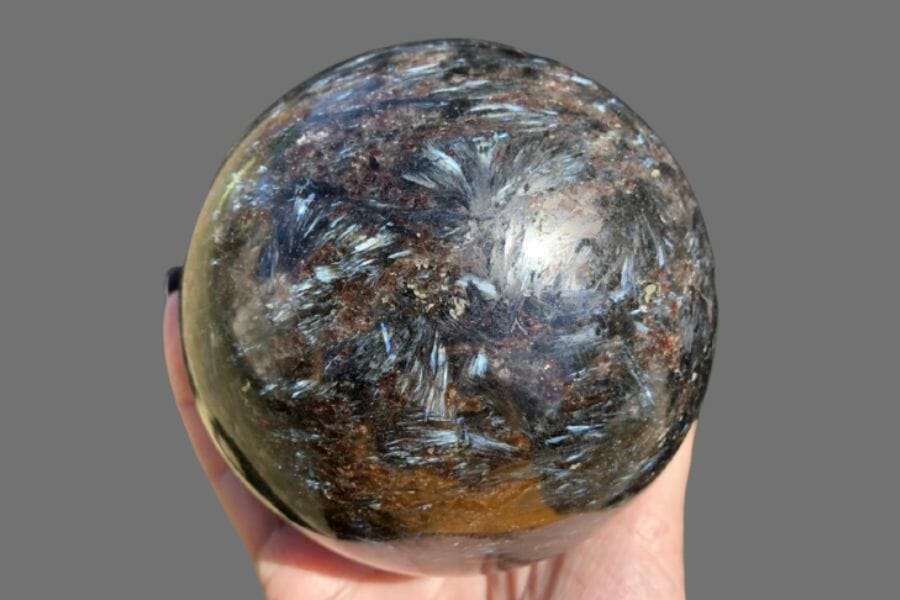
Arfvedsonite is a sodium-rich amphibole mineral that was first discovered in 1823. It’s a relatively rare mineral that is mainly used by mineral collectors and gemstone enthusiasts.
Arfvedsonite is often associated with alkaline rocks and is known to form in the later stages of magmatic processes, particularly in silica-undersaturated systems. It’s valued for its unique color and physical properties, which make it an interesting mineral to study and collect.
It is also used in gemstone jewelry, although it is not considered to be a valuable gemstone due to its relative rarity. Overall, Arfvedsonite is an intriguing mineral that continues to attract the interest of geologists and mineral collectors alike.
Fun Fact Arfvedsonite may be one of the few minerals that are NOT named after its discoverer, but after their friend! It was first discovered by a Swedish chemist and mineralogist, Jöns Jakob Berzelius, in the forest of Norra Kärr in Sweden. Berzelius named it after his friend and fellow chemist, Johan August Arfwedson.
Where Arfvedsonite is found
Arfvedsonite is commonly seen in specific areas such as the Kola Peninsula, Russia, Norway, Canada, and the US, specifically in Maine, California, and New York. In Russia, it’s found in the Khibiny massif, where it’s extracted from the eudialyte-rich rock formations, while in Norway it’s seen in the Langesundsfjorden area. In Canada, it’s been found in the God’s lake greenstone belt, Quebec. This mineral is known for its scarcity, and its discovery in several countries across the world has created a demand for it among mineral collectors and scientists.
How you can identify an Arfvedsonite
- Color: Arfvedsonite is usually found in shades of green to gray, with varying intensities. Some specimens can also exhibit a brown or yellow tint. It’s rare to find Arfvedsonite in any other color.
- Hardness: Arfvedsonite’s hardness is 5.5-6 on the Mohs scale. It’s relatively hard and durable, but can still be scratched.
- Clarity: Arfvedsonite’s clarity is usually cloudy to translucent. It has a fibrous or granular structure and its inclusions can be present that can affect its overall clarity.
- Refractive index: Arfvedsonite’s refractive index ranges frm 1.639-1.646, which is moderately high. It also displays double refraction, which is a characteristic of minerals with biaxial optical properties.
- Specific gravity: Arfvedsonite’s specific gravity is approximately 3.3. It’s considered a heavy mineral, which is higher than most common minerals.
Wolframite – (Fe,Mn)WO4
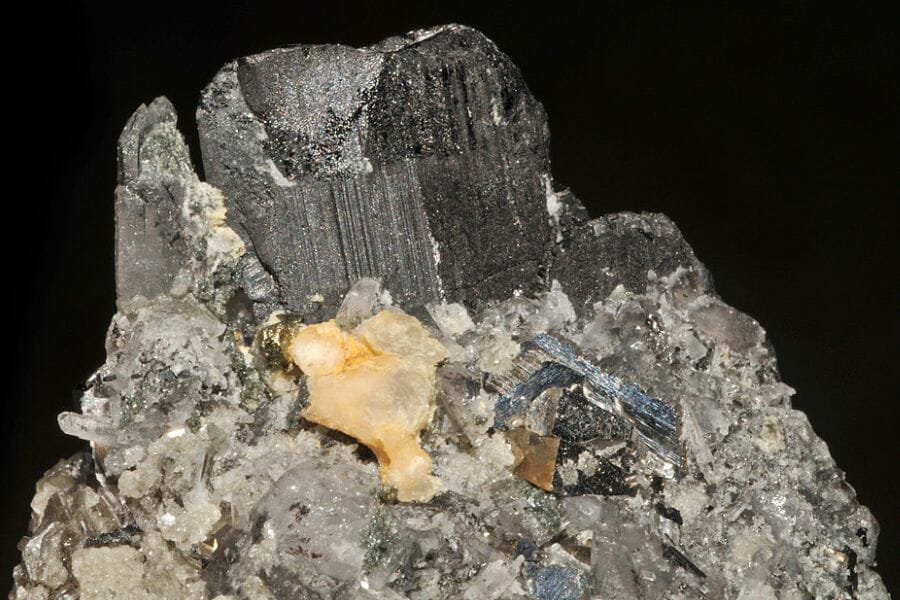
Wolframite is one of the strongest, toughest metals that has a high melting point. It was first discovered in the late 18th century and has been mined since then.
Wolframite has a number of uses and is considered valuable for its tungsten content. Tungsten is used in the production of various alloys, including steel alloys, which are used in the construction of buildings and bridges. It’s also used in the manufacture of electrical wiring and in the production of tungsten carbide, which is used in cutting tools and other applications.
In addition to its practical uses, Wolframite is valued for its beauty. Some specimens have an attractive, metallic luster and can be used in jewelry and other decorative items.
Fun Fact: Did you know that pure Tungsten stands are not found in nature? Yep! It's mostly fused with Wolframite that's why in many parts of the world, Tungsten is known as Wolframite.
Where Wolframite is found
Wolframite is a mineral that can be found in several countries including Australia, Canada, South Africa, Russia, China, Portugal, and Spain. It’s also found in a few other locations across the globe, as it’s not exclusive to one region alone. Wolframite can be found in the form of tungsten ore that is used in many industries today. The demand for tungsten has led to an increased search for Wolframite deposits, making the mineral an important resource for many countries.
How you can identify a Wolframite
- Color: Wolframite’s color ranges from black to brown, with some specimens having a metallic luster. It’s often described as having a “gunmetal-gray” color, giving it a unique appearance.
- Hardness: Wolframite has a hardness of 4-4.5 on the Mohs scale. It’s relatively soft for a metallic mineral and can be scratched easily with a knife.
- Clarity: Wolframite’s clarity varies: it can appear opaque to translucent with a metallic luster. It may have a sub-metallic or a dull appearance and, in some cases, it may also have a streaky or fibrous texture.
- Refractive index: The refractive index of Wolframite generally falls within the range of 2.0 to 2.2, but it varies depending on the amounts of iron and manganese in it. This is considered a moderate refractive index, and is one of the characteristics that distinguishes it from other minerals.
- Specific gravity: Wolframite’s specific gravity is typically around 7.0 to 7.5, which is relatively heavy. It’s composed of tungsten and iron, two elements that are relatively dense. Wolframite’s high specific gravity means that it will often settle to the bottom of a stream or other deposit, making it easier to locate and extract.
Stephanite – Ag5SbS4
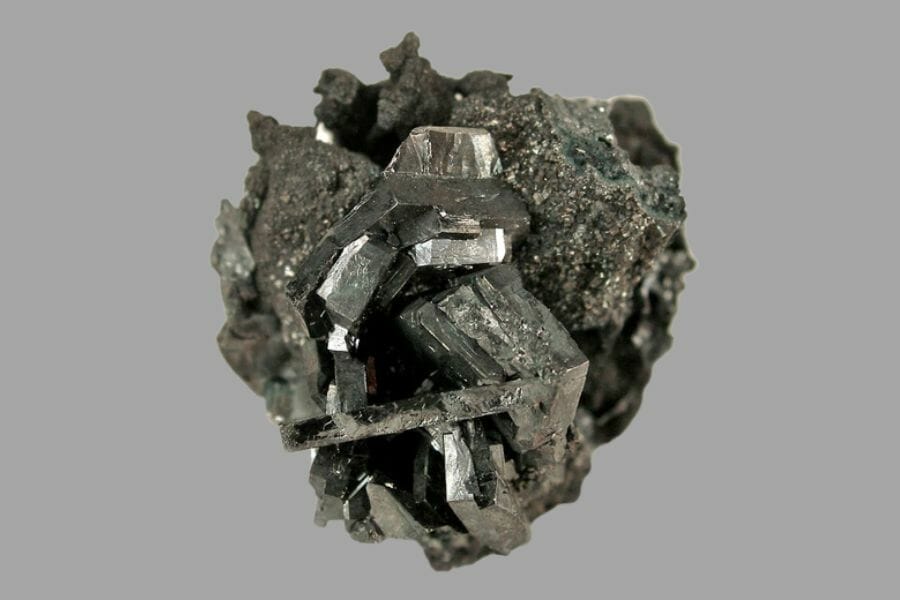
Stephanite is a rare sulfosalt mineral that was first discovered in 1831 in Przibram, Bohemia (now Czech Republic). It has a unique metallic luster, making it a sought-after mineral by collectors. However, its rarity and relative unknownness have limited its commercial value.
Despite this, Stephanite has been used in various industrial applications, including the production of silver and antimony, as well as in the manufacture of electrical conductors and other electronics.
In recent times, Stephanite has become more popular among mineral enthusiasts and collectors due to its relative rarity and interesting characteristics. Its metallic luster and pale-silver color make it stand out among other minerals.
Fun Fact
Stephanite is actually named after the Greek word "stephanos," which means "crown." This was in reference to its luster and its frequent occurrence in crown-like formations.Where Stephanite is found
Stephanite is found in a number of different locations around the world, including Mexico, USA, Russia, and Central Europe. It’s often found in association with other minerals, such as silver and gold. In Mexico, Stephanite is extracted from mines in the state of Sonora. Despite its beauty and value, it is relatively rare and can be difficult to obtain, which makes it highly prized by collectors and gem enthusiasts.
How you can identify a Stephanite
- Color: Stephanite is a silvery-gray mineral with a metallic luster. Sometimes, it can also have a slightly yellowish tint.
- Hardness: Stephanite has a hardness of 2.5-3 on Mohs scale. It’s relatively soft and can be scratched easily with a fingernail. It can also be easily cut or broken with a knife. Despite its softness, it’s still durable enough to be used in jewelry-making.
- Clarity: Stephanite has a clarity ranging from transparent to opaque. Transparent specimens are rarer and can have a clear, sparkling appearance when properly cut and polished. Opaque specimens, on the other hand, are more common.
- Refractive index: Stephanite has a refractive index of 2.10-2.12, which is a moderate value. With its moderate level of light dispersion, this mineral has moderate brilliance, which gives it a distinctive sparkle.
- Specific gravity: Stephanite has a specific gravity of 7.0-7.2. It’s considered to be a heavy mineral, which makes it suitable for use as a weight in jewelry-making.

